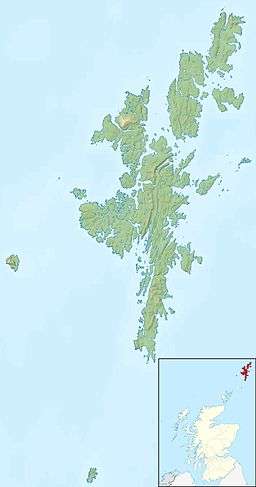Bigga, Shetland
| Norse name | bygdey |
|---|---|
| Meaning of name | Old Norse for "island of the building" |
| Location | |
 Bigga Bigga shown within Shetland | |
| OS grid reference | HU444792 |
| Physical geography | |
| Island group | Shetland |
| Area | 78 ha (0.30 sq mi) |
| Area rank | 164= [1] |
| Highest elevation | 34 m (112 ft) |
| Administration | |
| Sovereign state | United Kingdom |
| Country | Scotland |
| Council area | Shetland Islands |
| Demographics | |
| Population | 0 |
| References | [2][3][4][5] |
Bigga is an uninhabited island in the Sound of Yell between the Mainland and Yell in Shetland, Scotland.


Geography and geology
Just over 1,000 metres (1,100 yd) long, Bigga is 78 hectares (0.30 sq mi) in size, and is 34 metres (112 ft) tall at its highest point. Bigga is a long thin island with a "head" and a "torso". The neck is formed by the bays of Wester Hevda Wick and Easter Hevda Wick, "hevda wick" being an anglicisation of the Norn/Old Norse for "seaweed bay".
Cattle and sheep were formerly farmed here.
The island is split between the parishes of Delting, and Yell.[6]
Bigga consists of Moine bedrock of coarsely-crystalline gneiss and quartzite.[3]
History
It is thought that the name comes from the Old Norse bygdey meaning "island of the building", which may refer to an old structure.
In the southern part of the island, there is an old well, chapel and burial ground. There is a small prehistoric cairn in the north of the island. In the north is the remains of Norrabister, the island's "settlement".
The Pribislaw, a 160-year-old German sailing vessel ran aground here in 1870. She had been one of many sailing boats that took German emigrants from Hamburg to Victoria, in Australia, around the middle of the 19th century. Moved to Lerwick, she was used as a store and workshop until the 1950s. In 2005 the remaining timbers were excavated and transported to Whittlesea, Australia.[7]
During World War II, two sailors from neighbouring Yell wanted to return to their native island to celebrate Yule (Christmas) during their shore leave. The weather was stormy and snowy and the usual ferry between the Mainland and Yell was not running, so they borrowed a friend's boat. Forced to land on Bigga, they sheltered in the bothy and danced, and played the fiddle in order to stay warm. They managed to reach Yell the next day.[3]
Footnotes
- ↑ Area and population ranks: there are c. 300 islands over 20 ha in extent and 93 permanently inhabited islands were listed in the 2011 census.
- ↑ 2001 UK Census per List of islands of Scotland
- 1 2 3 Haswell-Smith, Hamish (2004). The Scottish Islands. Edinburgh: Canongate. ISBN 978-1-84195-454-7.
- ↑ Ordnance Survey
- ↑ Anderson, Joseph (Ed.) (1893) Orkneyinga Saga. Translated by Jón A. Hjaltalin & Gilbert Goudie. Edinburgh. James Thin and Mercat Press (1990 reprint). ISBN 0-901824-25-9
- ↑ "Bigga Isle". British History online. Retrieved 2015-06-05.
- ↑ "Pribislaw on her last voyage". The Shetland News. February 2005. Archived from the original on 2007-09-27. Retrieved 2008-01-05.
Coordinates: 60°29′42″N 1°11′27″W / 60.49500°N 1.19083°W